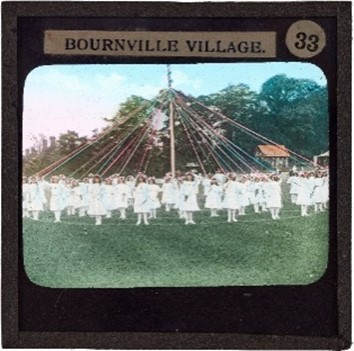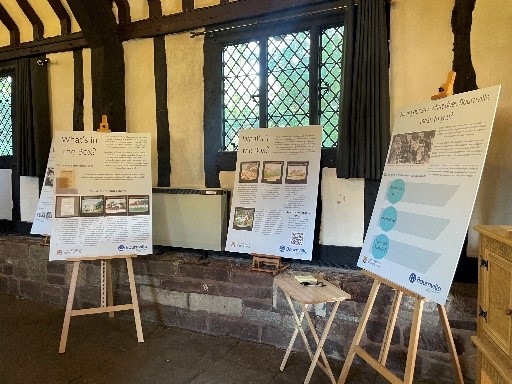My name is Anna Norton, and I am an undergraduate student, studying BA History and Anthropology. I participated in the Collaborative Research Internship over the summer period in the Project “What’s in the Box? The Mystery of the Lantern Slides”.
On this project, I worked alongside my colleague intern Jo Birch, with the help of our supervisor Matt Houlbrook and Tara Hamling from the department of History at the University. We began the project by viewing a wooden box, containing approximately fifty lantern slides which depicted early twentieth century images (photographs which had been painted to become colourised) of picturesque scenes of Bournville Village. Bournville, in Southwest Birmingham, is famous for being the home of the Cadbury’s chocolate factory, and as many more local people may know, the village itself is known as a “model village”, and an experiment in housing, started by the Cadbury family and developed and maintained by the Bournville Village Trust.
During the course of my second-year history course, I had undertaken a group research project which focused on the general history, and more specifically what it is like to live in Bournville village throughout time. This is what initially drew me to the project, as I had prior knowledge that would help me to delve deeper into the mystery of this lantern slide box. Therefore, with the team, as well as through individual research, we sought to uncover the story of local history shown in the lantern slide images, and the ways in which they were used.
The process of the research internship included lots of archival research, working with Daniel Callicott and other members of the Bournville Village Trust Heritage Team, as well as visits to the Birmingham Library archives at the Wolfson centre. By sorting through archival records such as early twentieth century maps of the village and publications on the history of certain landmarks in the village by the Bournville Village Trust, we were able uncover many specific details about the images shown on the lantern slides. Here is an example, which has also been used on an information board at Bournville Heritage Day:The image on this slide depicts approximately one hunded children from the Bournville Village School, clothed in white dresses and flower wreaths, performing maypole dances at the annual Bournville Village Festival, held on the men’s recreation grounds of the Bournville Works. This tradition began in 1902 and was organised by the Tenants Committee to promote the social, educational, and recreational life of the village. The itinerary of the day also included: a procession to the grounds, a performance of a play by around two hundred children (such as “Trouble in Fairyland” in 1913), fancy dress competitions, competitive sport and Punch and Judy shows. This tradition continues in Bournville Village today.


However, the main challenge lay behind discovering how the lantern slides were used. We had been informed that the lantern slides were used alongside a lecture, and I was provided the lecture script that came with the box of slides. I found the task of finding the precise occurrence of the lecture particularly interesting, and contacted an archival team at the Wellington College, Berkshire, to find out more information about the lecture. The archival team there were particularly helpful and were able to find the exact occurrence of the lecture in their records; it took place on the eighteenth of March 1906, performed by Mr. Clarkson Booth to the aegis of the school’s Natural Science Society. It was particularly rewarding to be able to piece together the history behind the lecture and the slides themselves, as an original contribution to local history. Once we had uncovered where, when, and who the lecture was performed by, it was time to bring all this information together into an overall analysis- the story of the lantern slides, to be adapted to a non-specialist audience, so it can become accessible to the public.
Overall, I would say that this internship has certainly highlighted an interest in local history for me. A practical aspect of this project which I found useful was learning to catalogue the images of the lantern slides. This included cataloguing the images themselves, along with descriptions, contextual information, as well as the locations of the buildings shown in the images. As a History and Anthropology student, this was a new skill that this project has taught me, and it will certainly be valuable for working with archival sources in my future dissertation research.
